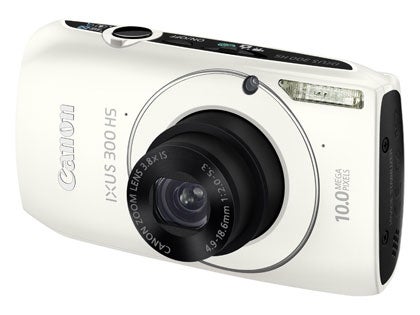A great looking compact with the on-paper potential to be one of the best...
Canon IXUS 300 HS Review
The IXUS 300 HS is the latest in a long line of stylish, simple to use compact cameras from Canon offering 10MP stills, a 3.8x zoom and both HD and slow motion movies. Images can be taken at a rate of up to 8.4 per second at a lower resolution and there’s the opportunity to take manual control of both the aperture and shutter speed.
Features
In spite of it’s fantastic looks, the IXUS 300 HS isn’t simply a vacuous attempt at enticing the consumer into purchasing another standard compact. The features that differentiate it from the models below are based around speed, or more accurately capturing it. Both the 240fps low-res movie mode and 2.5MP 8.4fps stills mode are a way off the camera’s full quality in terms of image resolution, but both proved to be useful beyond the novelty value and capable of inspiring an amount of creativity. The 720p HD movie mode ticks the necessary box that most compacts must seemingly provide, but the manual shutter and aperture control provide something outside what the aesthetics of the IXUS would infer. Not only is it impressively good-looking, but there’s an obvious lack of buttons to steer the user towards the relevant functionality. With a 3″ LCD dominating the relatively diminutive rear there’s very little space for any type of controls, which has both positive and negative ramifications for the functionality of the camera.
Design
Just four buttons sit next to the screen, and being that the Playback and Menu buttons aren’t doubling up to perform other functions it falls to the dial/D-pad to control the majority of the navigation. It can be either spun or pressed to change values, and has some intuitive features such as zooming out within playback mode if the dial is turned too rapidly so more images can be seen. The same sentiment can be applied when the shutter and aperture priority modes are employed, as the dial is very intuitive, although the multi-function nature of the d-pad isn’t physically labeled on the camera making it difficult to access the functions rapidly. The screen is impressively detailed and bright, and images are simple to frame as a result. The fact that the manual controls are within menu screens means the IXUS 300 HS isn’t the most conducive to shooting manually, but it at least manages to make the process of altering settings simple once the mode is selected. Thankfully the design of the camera doesn’t hinder the operation, with the matte surface making it far easier to grip than compacts with a shiny, smooth front.
Image Quality
‘Only’ having a 10MP sensor in the current climate puts the IXUS 300 HS at somewhat of a disadvantage from a numerical point of view. In actuality the images produced by the IXUS 300 HS are equal to models of higher megapixels, and seems to take most genres in it’s stride. With only a 3.8x optical zoom there’s not much in the way of versatility in the lens for closer cropping, but the speed and accuracy of the focusing more than makes up for it. Even when the camera is switched to the automatic exposure mode it barely pauses when changing from landscape to macro mode, and the lens is equally as rapid. This made up for the lack of magnification to some extent, as the focus distance is far closer than some longer zoom models. Having image stabilization helps the focusing hugely, even though the magnification won’t cause as many issues as a 10x zoom model, and the bright f2 lens insures as much light as possible hits the sensor. The result is impressive low light performance with each ISO setting being printable in our tests, only showing slight touches of pixel smoothing to spoil the detail. Even into the upper echelons of the ISO colour is maintained in impressive fashion, and further down the scale there’s an excellent degree of punch and contrast. The built-in contrast control manages the detail levels in high and lowlight superbly, and needs little assistance manually from the user to expose a shot well.
Value
The only real downside to speak of, which is a frequent gripe with the IXUS range, is the price. At £20 shy of £400 RRP and a fair way to go before even the street price matches those of it’s rivals, the IXUS 300 HS has an uphill battle to fight. Although the camera is excellent on most fronts having to justify the extra £100+ over it’s rivals is extremely difficult.
Verdict
A superb camera which manages photographs with excellent tone, contrast and sharpness. It's just a shame it costs so much.





